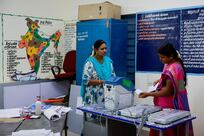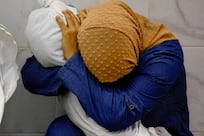Chris Lemons is a lucky man.
On September 18, 2012, while doing routine maintenance work on an underwater structure at the Huntington oilfield in the North Sea, the umbilical cable connecting the diver to a diving bell, providing him with electricity, heat and gas for breathing – everything he needed to survive in the freezing, impenetrable murk – severed almost 100 metres beneath the waves. On his back, he carried a short supply of bail-out gas. As this ran out, Lemons fell unconscious, headed towards a grim, lonely death.
Or so it seemed. For despite being in the water without air for around 30 minutes, and for reasons that no one has been able to explain with any certainty, Lemons lived.
Seven years later, the survival story that set the commercial diving industry abuzz is the subject of a gripping documentary, Last Breath.
Over 90 minutes, directors Alex Parkinson and Richard da Costa use archive footage, seamlessly integrated reconstructions and direct-to-camera interviews with some of the main people involved, including Lemons' teammates, Dave Yuasa and Duncan Allcock, and dive supervisor Craig Frederick, to take us inside not only the race against time to rescue Lemons, but also the esoteric world of saturation diving.

For this discipline, divers are prepared for working deep underwater by being sealed inside a system of metal chambers that is gradually filled with heliox – an inert mixture of helium and oxygen that can be breathed under pressure without the dizzying effects of air – until the internal pressure equals the weight of the water in which they'll be operating.
Known as "blow down", the pressurisation phase can be uncomfortable. The chamber gets "exceedingly hot", Allcock tells The National.
"If you're going deep, then a lot of people, their joints seize up," says Yuasa. "Any kind of old injury you might have had, that seems to come back."
The space inside the chambers, which can be home to four three-man teams of divers working overlapping 12-hour shifts for up to 28 days, is small, and fists have been known to fly. "I don't think you could legally put six dogs in one of these tanks," Frederick wryly suggests.
“You’ve got to be tolerant of people,” adds Yuasa, whose unflappability would prove vital in saving Lemons. “And it’s no good if you’re claustrophobic, obviously. You’ve got to have, on some level, a sense of humour about the whole thing, and give people their own personal space, when physically there’s none of it.”

The job is dangerous, but the divers, who are very well paid, play this side down at home. Today, the North Sea is the gold standard for safety, and the only place Allcock will work. But despite every job being risk assessed, “It’s very hard to make it safe,” Yuasa insists. “It’s safe as long as everything goes right. And if it goes wrong, it’s instantly dangerous.”
When Allcock, Lemons and Yuasa left their temporary tubular home on the Diving Support Vessel (DSV) Bibby Topaz, on that day in 2012, and descended to work in a pressurised diving bell, no one foresaw that while the latter two divers were inside a drilling structure testing valves and pipework, the Dynamic Positioning system keeping the ship in place would suddenly suffer a catastrophic malfunction, causing it to drift away.
In response to an alarm in Dive Control, Frederick ordered Lemons and Yuasa to get on top of the framework. They complied, but Lemons then realised that his umbilical cable was snagged on something and being pulled tighter by the diving bell, which was connected to the out-of-control DSV.
Inside the bell, Allcock attempted to feed him some more line, but it was "so tight, there was no way I could pull more umbilical cable off … It was literally pulling the rack, which is like, four-inch stainless-steel bars, off the wall."
At the same time, Yuasa was being dragged off the structure by his umbilical cable. Suddenly, he heard a loud bang as Lemons’ line snapped. He called for more umbilical cable so that he could try to reach Lemons, and got within a metre of him, but it was already too late.

"I was getting pulled through the water," Yuasa recalls, "and was a little bit worried that there could be some trouble coming for me as well, because there were other things down there that could have caught me up."
Yuasa made his way back to the bell – “which is the only place I could have gone anyway, really” – and clung to the platform beneath it, awaiting further instructions from Frederick. As the minutes ticked by, the likelihood of finding Lemons alive became more remote. “I think you’re meant to have a minute of breathing gas for every 10 metres of umbilical cable that you’ve got [they had 50 metres], and that’s enough to get you back to the bell, and no more,” says Yuasa. “I didn’t have a watch on, but I knew it had been a lot more than five minutes.
"So I thought he was definitely going to be dead. I just hoped it was quick and that it hadn't hurt."
Eventually, the DP system was brought back online and the Bibby Topaz returned to its original position. Yuasa dropped off the bell and recovered what he thought was Lemons' corpse. He took it back to Allcock in the bell, who removed Lemons' helmet to alarmingly discover that the diver's bald head had gone completely blue. Allock performed CPR on Lemons, and was amazed when he took a deep gulp of air.
Allcock was jubilant – he knew Lemons onshore and thought he’d have to tell his friend’s then-fiancee, Morag, that he’d died.
Yuasa, meanwhile, was thankful that they weren’t going to have to spend four days in a decompression chamber with a dead body. “When he turned out to be OK it was a massive relief.”
Frederick believes they'll never know "the science that went into him surviving", although he thinks the particularly high amount of oxygen they'd put in Lemons' bail-out tank that day may have helped.
"It meant his blood was saturated with oxygen. And the cold helped him because the brain was going to shut down all the other bits before it shut itself down. And he didn't actually drown," he says. "He just stopped breathing. But how he survived, I'll never know for sure."
Last Breath is streaming on Netflix now






